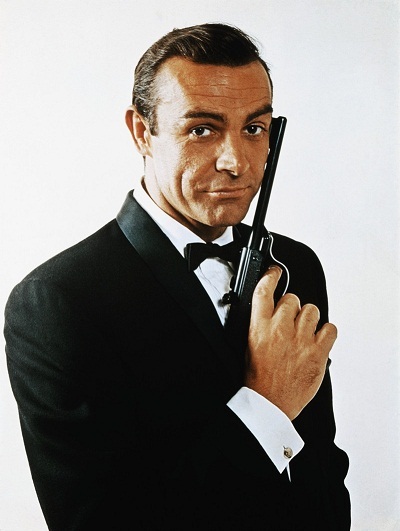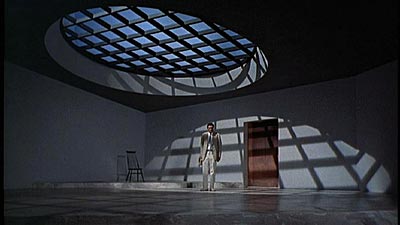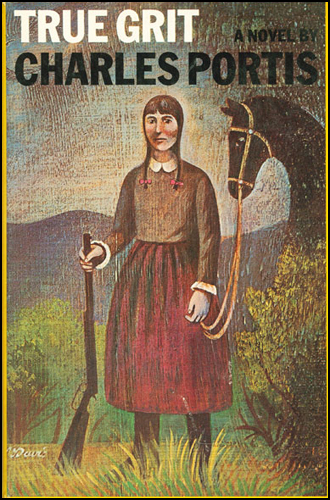I have not seen Dr. No since the late 80’s, and had virtually no memory of it. Having watched six new Bond films in the interim, the latest being Quantum of Solace, a return to the 60’s milieu of the franchise came as quite a bit of culture shock. I’m pleased to report (as if I need to) that the film holds up rather well in some regards, while also being highly representative of early 60’s-style film.
Of course, we must begin with Sean Connery. Readers of Big Hollywood know that we make quite a big deal about the feminization of men in contemporary popular culture. We hate it. Mr. Connery provides viewers with a reminder of what it means to cut a masculine, edgy, dangerous figure in film. The Bond of Dr. No is supremely confident as he strides around Kingston in suit and tie, Walther PPK in his shoulder holster, and roving eye.
It is Mr. Connery’s directness that is captivating in almost every scene. He has a way of asking one to do something without any politeness whatsoever and, well, people just jump. Indeed, after being captured by Dr. No, he and Honey Rider (Ursula Andress) are being decontaminated…and he orders No’s henchmen to take off his handcuffs. They oblige! Now that’s a commanding presence.
Also evident is Bond’s alertness and intelligence. He knows full well he’s being photographed at the airport; is smart enough to phone the home office to see if the car sent for him is friend or foe; sets a lock of his hair across his closet door to alert him if anyone has been snooping in his hotel room; and arranges Taro’s house to appear occupied as he awaits an assassin. These quiet little moments have been lost in contemporary film, and it’s a shame. They reveal a lot, and support the masculine confidence of Mr. Connery.
He’s Bond, James Bond
It’s also easy for today’s viewer, steeped as we have been in casual violence, to blink right past the fact that Bond really takes no prisoners. In fact, he has a ruthlessness that Mr. Connery plays with what must have been refreshing — even shocking — nonchalance. Miss Taro (Zena Marshall), the secretary in the Governor-General’s office, is a mole working for Dr. No. She invites Bond to her remote house in the mountains. On the way, the Three Blind Mice (see video below) fail to run him off the mountain road. His suspicions confirmed that Taro is a mole, he surprises her at her home. Bond is very aware that the ensuing phone call is a check on the assassination attempt and allows Taro to report it failed. Thus, he now expects another assassin to arrive at some point.
Until the assassin shows up, however, he could have sat Taro down and waited. But no, he seduces her instead. This is completely unnecessary — unless you are James Bond. Contemporary Bond viewers coming to the film for the first time might miss this point, so used to seeing Bond bed every other woman that shows up in Bond film.
Bond subsequently has Taro arrested. And in case you think he isn’t a brutal bastard, after Prof. Dent (Anthony Dawson) empties his gun into the bed, thinking he’s killed Bond, ol’ James plugs him once in the chest. He hits the floor, face down. And then, without even getting up from his chair, slams another bullet into Dent’s back.
Cold…and controversial at the time.
These moments are used sparingly in Dr. No, and therefore to great effect. In fact, the film begins innocently enough, with three apparently blind men, making their way with walking sticks to a hotel. With a Calypso version of the nursery rhyme Three Blind Mice playing underneath, we are lured into a lighthearted tone that is suddenly, shockingly, broken when these same men pump numerous bullets into the local MI6 agent. Moments later, the agent’s secretary is going about her business in the office when there are several shock cuts — she screams, we see the Blind Mice in the windows and doors, and they kill her. Only later might viewers wonder why exactly these men pretended to be blind, walked several miles to a hotel, likely drawing a lot of attention to themselves traveling as a caravan of three well-dressed gentlemen. Ah, well, no matter. They are the first of many colorful nemeses to appear in the series. (Relevant clip begins at 2:43)
James Bond jagt Dr. No 1/10 – MyVideo
We Have No Need of Doctors
Unlike many other Bond films, we do not get a glimpse of Dr. No until late in the film. In fact, he gets a better star entrance that Mr. Connery. Joseph Wiseman’s villain is first only heard — a disembodied voice in a sealed chamber — calmly threatening Prof. Dent. Later, with Bond drugged in a 5-star villain’s lair guest suite, the good Doctor is seen only as a shadow, a pair of thin legs in white linen pants, and a strange black glove.
We see him in all his calculated, rigid glory as he eats dinner with Bond. Again, contemporary viewers have seen portrayals like this before. Viewing the film through the prism of the 1960’s, however, Wiseman’s character is rather imposing. Like Bond, he seems to be in complete control. He is intelligent, ruthless, unblinking, and several steps ahead of his opponents. He has two metal hands that lack full range of movement, but can crush steel.

The dinner scene is intriguing. Although the reason for the tete-á -tete has since become a cliché, here it illuminates. Bond has impressed Dr. No. He wanted to get a first-hand look at such a formidable opponent, thinking he might make a good recruit for SPECTRE. Bond’s devotion to duty, however, disappoints No. In fact, this rejection coupled with No’s backstory, also gives the audience some nice subtext to No’s character. He we have a man who screwed the Chinese Tong Society out of $10 million, offered his services to both Eastern and Western intelligence agencies, got rejected, and turned to SPECTRE. It’s lonely being an evil genius, and SPECTRE would appear to be the Island of Misfit Toys for those too brilliant to be accepted elsewhere. There’s probably something interesting here as far as SPECTRE’s relationship to the Anarchist Movement, but I’ll save that analysis as we delve deeper into the franchise.
The German Influence
From a character standpoint, one might make an argument that Bond and No are doppelgangers — a German term meaning “double” or “mirror image”. The men share several traits — both are cold-blooded killers, ruthless, and confident. However, Bond chooses to clothe himself as a member of society, in suit and tie, working for the good guys. He is warm, charismatic, masculine, social, virile, and uses a gun. Dr. No is an outcast, dresses androgynously, is cold, stone-faced, sexless, rigid, and probably hasn’t been laid in quite some time (and probably doesn’t care).
In addition, the doppelganger is something often seen in German Expressionist films, which the production designer, Sir Kenneth Adam, admits to loving. Those familiar with this style will note that Dr. No’s first visual appearance is as a long angular shadow on the floor of Bond’s guest room. His white lined suit contrasts with his black metal hand. The use of skewed angles, shadows and contrast are something frequently seen in the films of the German Expressionists. The chamber where Prof. Dent is placed reeks of it.
Designing The Film
This leads to what I found the most interesting part of the film — its design. Sir Kenneth provides students of film and design with a great education in Dr. No. When confronted with a limited budget, a great designer can really give visual pop to a movie. On your next viewing of the film, take particular note of the use of shape, contrast, and space.
Many of the film’s earlier sets are filled with squares and rectangles, from the chairs and tables to the wall fixtures. Later, in Dr. No’s lair, we are treated to a lot of contrast of shape — its intent is to give the audience an unsettled feeling, and as a visual correlative to the conflict between Bond and No. You’ll notice circles resting inside of squares (such as round windows set inside rectangular doorways), and even circles in rectangular doors set inside the triangular prison room where Bond is deposited. Of course, there is also the extended escape scene of Bond moving through the circular ventilation shafts. Note also in this sequence the contrast of light and darkness.
Space plays a big role, as well. Almost every scene is Jamaica takes place in relatively flat space — that is, there isn’t much depth. The rooms are small and restricted. However, as we enter Dr. No’s base in Crab Key for the first time with Prof. Dent, we enter very deep space. He is led along a very long platform that stretches towards the horizon. And, of course, Dr. No’s lair is gigantic and filled with deep space perspective.
I could go on and on, but why not discover if for yourselves?
It will not surprise readers to learn that Sir Kenneth also designed the war room in Dr. Strangelove, won an Oscar for Kubrick’s Barry Lyndon, and was a consultant for Dennis Potter’s Pennies from Heaven. He also acted as production designer for six other Bond films.
I can’t conclude without a comment on Ursula Andress. Beauty is in the eye of the beholder. I behold her. Enough said.
All in all, Dr. No serves as a great start to the series. It is a strong work, with a commanding presence in Mr. Connery, and the hallmarks of the Bond franchise we have come to expect — without being overplayed.
Next time: From Russia With Love




COMMENTS
Please let us know if you're having issues with commenting.